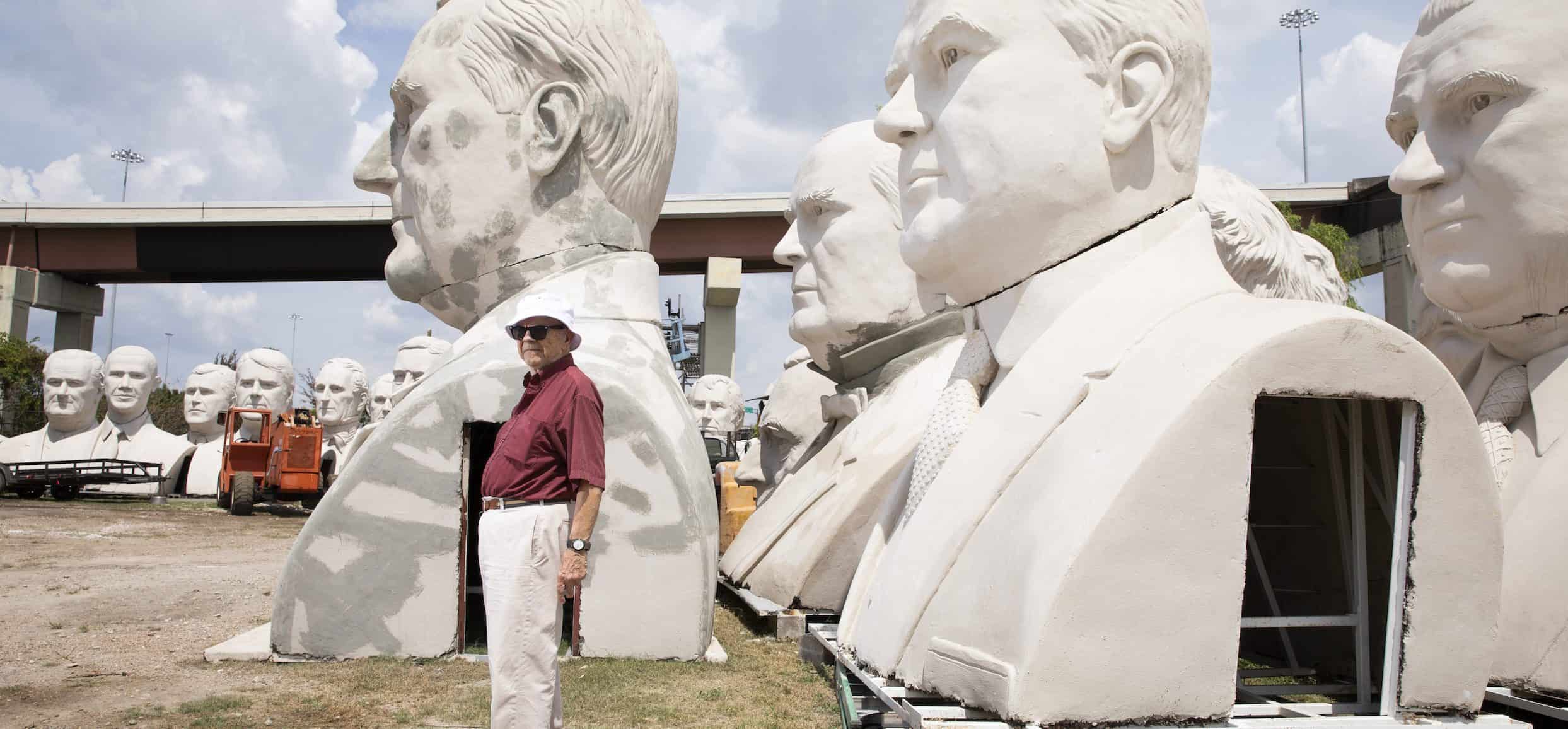
Where artists live, work, and play.
ARTS DISTRICT HOUSTON x FRESH ARTS
Fresh Arts is the managing partner of Arts District Houston and amplifies the district’s ability to serve artists and the greater community through artist-centered initiatives that help build capacity, audiences and shared resources for the artists and creative businesses that compose the district. Fresh Arts and Arts District Houston are dedicated to shaping and building Houston’s creative economy in a responsible way that ensures the district retains top artistic talent and energy while continually enhancing the livability of the surrounding neighborhood.
WHAT IS ARTS DISTRICT HOUSTON?
Arts District Houston embodies Houston’s up and coming creative economy. This colorful, urban, artist-centered community is situated in the city center along the Washington Avenue Corridor and touts the highest concentration of working artists in the state. Visit this lively historically designated area bound by two of the city’s bayous and feel the creativity flow throughout the creative businesses, restaurants, artists studios, and reimagined industrial spaces, notably the iconic repurposed rice silos and old Union Pacific rail line that run through it.
This state-appointed Arts and Cultural District has a rich history as it encompasses portions of both the 1st and 6th Wards, two of the city’s oldest neighborhoods. Arts District Houston is home to 300+ studio spaces for local artists, designers, and makers where you can see firsthand how art gets made. Experience art and architecture in the context of the preserved silos at the Site Gallery.
+ Read more
- Read less


ARTS
DISTRICT
ITINERARIES
DAY ONE: Savor the Moment in Arts District Houston
Arts District Houston has some of the best cuisine in the city. Depending on the mood, remedy a sweet tooth with a classic milkshake at Southwell’s Hamburger Grill or seek debauchery in the traditional Irish cocktail style at Poitín. Delight your taste buds with Belgian dishes at Cafe Brussels or a perfect burger at Stanton City Bites.
+ Read more
Dining options include irresistible fried chicken at Gus’s World Famous Fried Chicken or a steak in the luxurious environment at B&B Butchers & Restaurant. If you’re searching for a morning pick me up, look no further! Start your day off right with fresh baked pastries and espresso from Henderson and Kane general store or a refreshing seasonal loose leaf tea from Catalina Coffee Shop. Then, since you’re out and about, catch a live musical performance at Cafeza while snacking on Spanish tapas.
- Read less
DAY TWO: See Wonders in Arts District Houston
Our neighborhood is known for some of the most unique sights in town. We have the Sawyer Yards Art Alley at Silver Street Studios with Instagram worthy murals to explore. Visit The Silos at Sawyer Yards to witness 97 workspaces for over 100 artists, as well as the alternative art space SITE Gallery located across 34 iconic rice silos. Check out the Art Alley Mural Project at the heart of Sawyer Yards, the iconic President’s heads by sculptor David Adickes at American Statesmanship Park and the colorful ‘Rail to the Sea’ mural by local artist Janavi M. Folsbee for perfect Instagram pictures.
+ Read more
Then, browse the latest in hip clothing items at Reserve Supply Co. Catch a sketch or improv comedy show later that night at Station Theater or check out the Buffalo Bayou Park Cistern exhibit for mind-expanding architectural sights!
- Read less
DAY THREE: Indulge for the Night in Arts District Houston
Escape to a faraway place with Australian-inspired fare and handcrafted brews at Platypus Brewing.
Continue the night by savoring a ‘honey badger’ bourbon-based cocktail at Spring Street Beer & Wine Garden.
+ Read more
After the fun, grab a craft beer in a converted gas station at Liberty Station.
Later on, settle in for cozy 1920s bar vibes at Darkhorse Tavern or sip southern cocktail specialties at Julep.
- Read less
TAKE IN SOME HISTORY: 8 Must See Historic Sites in Arts District Houston
St. Joseph Church (est. 1902)
1505 Kane St, Houston, TX 77007Originally built in 1880 as a small wooden structure serving as both school and church for a growing Sixth Ward, the present day St. Joseph’s Church was officially dedicated February 23, 1902. In its life, the building has seen economic prosperity and survived social and economic upheaval and has been an anchor in the community, including playing a part in the restoration of its Sixth Ward neighborhood. A long line of ethnic groups have called the neighborhood and the church home from European to Mexican, African to Vietnamese.
+ Read more
In 1977 the St. Joseph’s Old Sixth Ward Multi-Ethnic Festival was created as the first citywide celebration of the various cultural groups that lived in inner-city Houston. Multicultural Education and Counseling through the Arts (MECA) began in 1977, as a result of this festival. St. Joseph’s pastor, Father Sam Rosales, asked MECA’s founder and executive director, Alice E. Valdez, to build upon the spirit of community created by the festival by developing a program that would provide alternative arts activities for the city’s youth and families. MECA received 501(c)(3) status and was incorporated in 1979; in 1993, MECA moved to its current home in the historic Dow School building in the Old Sixth Ward.
Richard Brock Park (1824-1906)
corner of Bingham and Sabine streetsRichard Brock was a former slave and businessman who purchased his freedom and land before President Abraham Lincoln in 1863 issued the Emancipation Proclamation. Brock, who owned a successful blacksmith shop, became one of Houston’s first black lawmakers when he was named alderman for Houston’s First Ward in 1871.
Brock was a founding member of two African-American churches, including St. Paul’s African Methodist Episcopal Church which was used as a school to help newly freed men, women, and children learn to read. In 1879, the school was relocated to a separate building (where Brock Park is currently located) and was known as the First Ward School for the Colored. In 1927, this school was renamed for Richard Brock.
Rice Grain Silos-SITE Gallery (est. 1960)
1502 Sawyer Street, suite 400, Houston, TX 77007The 83-foot-tall Success Rice silos, built in 1960, are within the old Riviana Foods complex which ended production in the early 80’s. A hive of 34 re-purposed grain silos is now home to SITE Gallery Houston. Self-strengthened in construction the silos were built by Texas Concrete Silo Company on-site. The circular shape of the structures winding counter-clockwise create the utmost in rugged strength and vertical trueness. Each stave unit is used to strengthen its adjoining companion.
Dow Elementary School (est. 1912)
1900 Kane Street, Houston, TX 77007The historic Justin E. Dow Elementary School was designed and constructed by C.H. Page and Brother in 1912, to serve as a model for other schools throughout the State of Texas. Located in the Historic Old Sixth Ward neighborhood, the building is registered on the National Register of HIstoric Places and has been designated as a City of Houston Landmark. Originally, this HISD School was a sixteen room building. Subsequent additions in 1926 expanded the building to twenty-eight rooms. HISD closed the school to students in 1991 and MECA moved into the building in 1993. The Dow School building is the oldest school originally built by HISD which is still open to the community.
In January 2004, the Old Sixth Ward Tax Increment Reinvestment Zone (TIRZ) purchased the property from HISD for MECA. MECA’s vision is that the Dow School continues to grow as a multi-faceted comprehensive community center that provides programs and services to children, youth, families from Houston and the surrounding communities.
Crockett Elementary (est. 1912)
2112 Crockett Street, Houston, TXFounded in 1912, Crockett Elementary predates the Houston Independent School District. The original building was demolished in the 1970s, rebuilt in 1980 and renovated in 2011. Named for Tennessee-born David “Davy” Crockett, the school is a fine arts magnet school that offers students lessons in flute, violin, piano, cello, percussion, bells, choir, and dance.
Henderson and Kane General Store (est. 1939)
715 Henderson St, Houston, TX 77007Originally built in 1939 and opened in 1941 as Scardino’s Food Shop, this building now houses Henderson & Kane General Store, the fifth shop of its kind in this space over the site’s more than 70 year history serving one of Houston’s oldest neighborhoods. It has been operated as Scardino’s Food Shop (1941-1956), DeStafno Grocery (1959-1973), Garcia’s Meat Market (1976-1983), Henderson Mart (1998-2010), and Henderson & Kane General Store (2018-).
Sixth Ward (est. 1874)
North of Buffalo BayouThe Sixth Ward began as the north portion of the Fourth Ward. The north and south portions of Fourth divided by an east flowing Buffalo Bayou. About three fourths of Fourth Ward fell south of the bayou. The remaining one fourth to the north resembled a slice of pie, pointing toward the town center and the Harris County Courthouse. Beginning with four wards for Houston government, the future Sixth Ward spent the first forty years as the north part of the Fourth Ward, becoming designated as the Sixth Ward in 1874.
Houston adopted the New York ward system in 1837, allowing ten wards to accommodate the future geographic expansion of the town. The ward system served to provide two elected officials from each ward to serve as aldermen to city government and represent the ward citizens’ needs and desires on regulations for the common good. During the next sixty-five years, the city used only six of the ward system numbers before switching to a commission form of government in 1905, eliminating the ward system.
Sixth Ward was created on April 18, 1874, at a time when industrial activity was on the rise in Houston. The bayou had been dredged to Main Street, and a street rail system opened connecting the Fairgrounds, Main Street, the Market House, and Union and Central Depots. The new rail cars raced along at ten miles per hour, mule drawn. Wiggins & Simpson established a large iron foundry along Buffalo Bayou in the Sixth Ward point. The Houston Waterworks Company opened in the Sixth Ward in 1879 to serve Houston citizens and hotels with artesian water from deeply dug wells.
The Sixth Ward Historic District, designated by the Department of the Interior in 1978, became the first National Register District in Harris County. It was named Houston’s first Protected Historic District in 2007.
Excerpt from Wagner, Janet. “Sixth Ward: Carving Out its Own Place”, http://houstonhistorymagazine.org/wp-content/uploads/2011/07/Sixth-Ward.pdf. Accessed 28 August 2018.
Dentler House (est. 1923)
1809 Summer St., Houston, TX 77007The Dentler Building was erected by George H. Dentler in 1923 to house his growing potato-chip and condiments business. Potato chips were made in outbuildings in the rear, where fires are said to have broken out with some regularity.
Dentler Maid Potato Chips were made fresh daily and sold directly to consumers as well as through grocers across the city. George H. Dentler founded his food company in 1910, selling the potato chips, as well as horseradish, pickles, olives, mustard and other condiments.
In 1935, the business moved to a larger facility on the east side of Houston. Dentler built a grand home on North Boulevard in Broadacres. This building was sold and converted into a residential four-plex, with a barbershop reportedly having occupied one of the units for a time. It was rehabilitated for use as a single-family home in 2015.
- Read less




